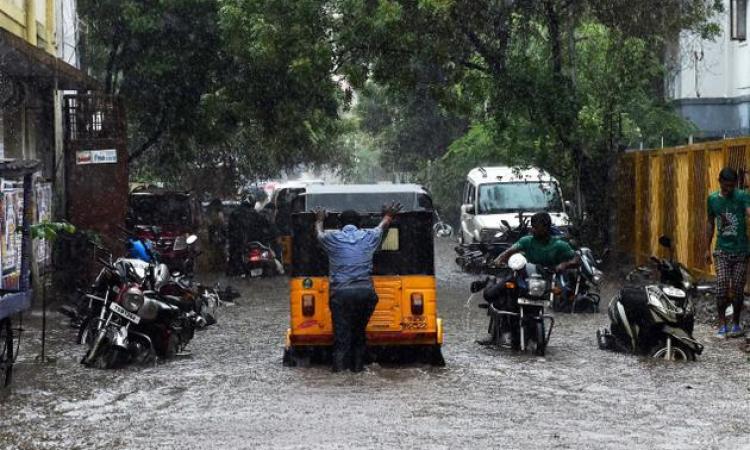
Chennai has historically been a water-starved region, but never rain-starved as it receives much of its annual quota during the northeast or ‘retreating’ monsoon between October and December. But this November was like no other.
The water level in Tamil Nadu for the week ending 11.11.2015 was 124.4mm, as against the norm of 49.3mm, a departure of nearly 152 percent. Chennai recorded a massive 239mm rainfall as against the expected 88.5mm, 170 percent more than usual [1].
While the rain was much needed, the massive downpour which the city would normally receive over a period of weeks came down in just three days. This tore down the city’s infrastructure to bits. Subways and underpasses quickly filled up and lakes threatened to breach. Apart from the capital, the coastal districts of Cuddalore, Kanchipuram and Thiruvallur were among the worst hit. The overall death toll in the state has touched 79 [2].
Chennai recorded 452.44 mm of rainfall in November 1976, it's highest yet. The Met department, in September, did predict above average rainfall this season and the state and local governments began de-silting storm water drains and constructing recharge wells in some pockets but it is difficult to assess the quality of the work done. Most of the storage reservoirs and other PWD tanks were highly silted, which reduced their carrying capacity. Blame it on shoddy work or faulty figures, but it finally appeared like the city and its suburbs were completely unprepared to handle what came their way.
The history and geography of Chennai
Situated along the Bay of Bengal, Chennai is drained by two rivers turned sewers while a third skirts the Northern fringes. Chennai Metro Water pegs the annual average rainfall range between 1200mm and 1300mm. Four main reservoirs–Poondi, Cholavaram, Redhills and Chembarambakkam–store and supply water to the city and its suburbs. The combined storage capacity of the first three reservoirs after desilting and raising tank bunds was found to be 7,412 Mcft back in 1991-92. With Chembarambakkam Lake added, the storage capacity went up to 11,057 Mcft, according to official 2000 figures.
Although the state was one of the pioneers of rainwater harvesting, monitoring and maintaining existing structures was apparently not its forte. With a misguided idea that storm water drains are the panacea for all that ails Chennai, the Corporation embarked on a massive plan to flood-proof the city. As a result, hundreds of kilometres of these concrete drains were constructed and now uselessly criss-cross the city’s underground filled with illegally-discharged sewage and garbage. The Corporation clears out the drains out periodically, but in the eternal battle of man versus garbage, garbage always triumphs. With most of the city’s underground drains clogged or contaminated and the limited availability of unpaved area, the water has nowhere to go.
Accreting chaos
In most parts of Chennai, people precede basic civic infrastructure. Plots are sold and houses constructed along river banks, lake fringes, and on wastelands even in the absence of Metro water and sewerage connections. The localities that remained marooned for days together are situated in the lowest points of the city. Velacherry is home to a large lake while Pallikaranai is essentially a marsh land around which, in the recent past, several high-rises have cropped up. Perumbakkam and Mambakkam house sizable lakes around which villas and residential complexes have mushroomed. The IT expressway along the Old Mahabalipuram Road cut across several water bodies very close to the Bay of Bengal on the East.
With several lakes and two rivers cutting across the city, the problem of encroachment is huge. It is not very difficult to spot shanties and illegal houses along the banks of the Rivers Cooum or Adayar. Many cascading tanks that had flood-proofed the city for decades now remain mere memories. The elevated Mass Rapid Transit System (MRTS) is almost entirely laid out along the Buckingham Canal. Most high rises along the IT expressway have been constructed on reclaimed marshland and their drainage lines. The administration must come down hard on such encroachers, big and small, regardless of political or caste affiliations.
When it comes to disasters, preparedness goes a long way in limiting if not completely eliminating, casualities. The importance of regular maintenance of tank and river infrastructure such as periodic repair and overhaul of bunds, taking prompt action against encroachers, and ensuring the safety of people in low-lying areas cannot be overstated. The city would do much better if officials show a bit more caution and prudence in granting plan approvals and building licenses keeping the city’s geography and geo-hydrology in mind.
References:
1. IMD Chennai – North East Monsoon Rainfall: Tamil Nadu and Puducherry
2. Chennai rains: what went wrong in the city? – Live Mint, 18 November 2015
Lead image courtesy: The Hindu